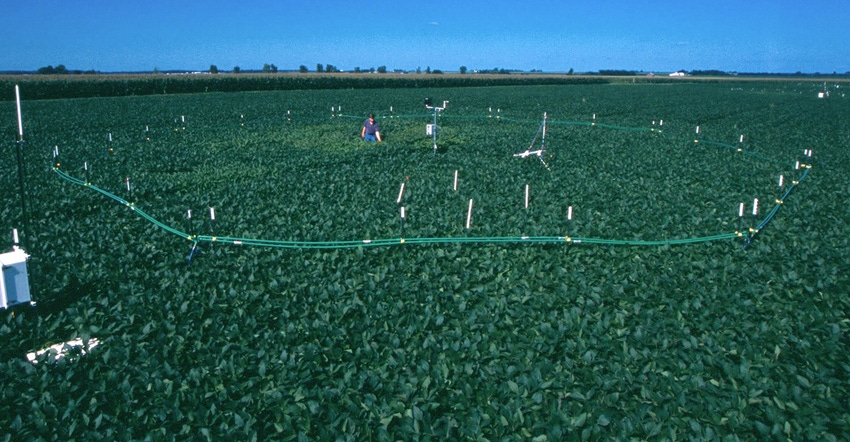
Crop sciences and natural resources lecturers went digital for the University of Illinois’ 63rd Agronomy Day, due to the coronavirus pandemic. But the good news for everyone at home: Every talk that would have happened live on the South Farms is now available online for viewing — and learning — at your leisure.
U of I’s Agronomy Day website is hosting 21 videos where experts from the university share what they’ve been working on over the past year. Here’s a look:
Introduction for Agronomy Day, hosted by Kim Kidwell, dean of the College of Agricultural, Consumer and Environmental Sciences.
Another introduction, hosted by Adam Davis, head of the Department of Crop Sciences.
Waterhemp resistance update, hosted by Patrick Tranel, professor and associate head of the Department of Crop Sciences. He talks about how scientists use genomics to track how waterhemp develops resistance to chemical controls.
Plant breeding, hosted by Alex Lipka, associate professor in the Department of Crop Sciences. He discusses how his lab helps to accelerate the breeding cycle for crops. He talks about the genomic approaches scientists are using to understand how plants develop herbicide resistance.
Fall-applied anhydrous ammonia, hosted by Richard Mulvaney, professor in the Department of Natural Resources and Environmental Sciences, and Kelsey Griesheim, graduate student in the Mulvaney lab. They cover the efficiency of fall-applied anhydrous ammonia in the Midwest.
SoyFACE, hosted by Chris Montes, graduate student working at the Soybean Free Air Concentration Enrichment research facility, or SoyFACE. He gives a general overview of the open-air research site that simulates what the atmosphere may be like years from now as the climate changes.
Currants: Agroforestry crop, hosted by Bruce Branham, faculty member in the Department of Crop Sciences. He shows viewers an agroforestry test plot where he’s growing nutritious black currant berries under mature tree canopies.
Genetic nematicides, hosted by Leslie Domier, research plant pathologist with the USDA Agricultural Research Service. He talks about how researchers are inserting foreign genes into soybean cyst nematodes.
Corn colorants, hosted by Jack Juvik, professor in the Department of Crop Sciences. He gives an update on a research project to use natural food colorants sourced from corn kernels to replace artificial food colorants in processed foods.
Red crown rot, hosted by Nathan Kleczeswki, plant pathologist with the Department of Crop Sciences. He distinguishes symptoms for red crown rot from other diseases with similar symptomology.
Corn rootworm, hosted by Nick Seiter, entomologist with the Department of Crop Sciences. He shows what an untreated check for corn rootworm looks like.
Banding vs. broadcast, hosted by Scott Foxhaven, doctorate student in Fred Below’s crop physiology lab. He discusses the benefits, breakthroughs and barriers of the two techniques for applying fertilizer.
Center for Digital Ag, hosted by Matt Hudson, co-director of the Center for Digital Agriculture. He talks about the center and the role it plays in sharing digital advancements in crop research with industry.
Weeds and weather, hosted by Christopher Landau, a doctorate student with Aaron Hager and Martin Williams. He explains how weather events like drought can cause worse yield impacts when weeds are left uncontrolled.
Green roof, hosted by Austin Little, horticulture educator with University of Illinois Extension. He talks about a research trial with a green roof on Southern Illinois University’s Carbondale campus.
Cereal rye populations, hosted by Lowell Gentry, research scientist in the Department of Natural Resources and Environmental Sciences. He shares how much cereal rye is necessary to reduce nitrate loss through tile drainage.
Slow-release phosphorus, hosted by Andrew Margenot, soil scientist with the Department of Natural Resources and Environmental Sciences. He discusses the results of a research trial looking at struvite, a slow-release phosphorus mineral.
Morrow Plots, hosted by Allen Parrish, manager of the Morrow Plots. He discusses the history of the oldest continually used experimental agricultural research fields in the U.S.
Soybean germplasm, hosted by David Walker, soybean breeder with the USDA Agricultural Research Service. He and the curator of the USDA soybean germplasm collection, Adam Mahan, talk about the historical importance of the collection.
Rootworm Bt resistance, hosted by Joseph Spencer, entomologist with the Illinois Natural History Survey. He talks about Bt resistance with western corn rootworm beetles.
About the Author(s)
You May Also Like




